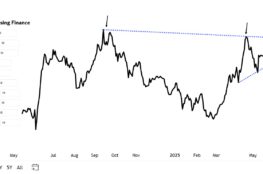Textiles & FTAs: A Shifting Landscape-
Tracking the India-U.K. FTA is crucial for the textile sector as it directly impacts export competitiveness, cost structures, and sourcing dynamics. It helps investors and businesses anticipate margin shifts, policy-driven demand changes, and new growth markets—especially as India competes with duty-free access nations like Bangladesh and China.
What do textile companies have to say in their latest con calls regarding the shifting landscape!
Arvind ltd
- “The overall messaging is there will be margin headwinds for 1.5 quarters (due to trump tariffs), but the demand scenario looks extremely robust. And this demand is here to stay. And so as the second half of the new financial year rolls around, we should start to see the advantages of this sort of rebalancing of the world. I think another watershed event, the signing of the FTA between India and the UK is also a very important event, especially for the textile and apparel business. I think India will become a very interesting sourcing destination for the UK. And I think it will also benefit Arvind quite significantly in securing the right kind of rebalancing to the US dependence. I think we are still heavily -- going to remain heavily indexed on the US as all our customers even there are only talking about increasing business rather than decreasing business. So I think that's the overall impact of geopolitics. I think this is the year where we should also add significant garment volume growth over last year in the textile space.” - PUNIT LALBHAI – VICE CHAIRMAN – ARVIND LIMITED
Banswara syntex Ltd
- “Significant development that has the potential to reshape India's textile trade landscape, the recently signed FTA between India and the U.K. This is a major step forward for the industry as it aims to eliminate tariffs and create a level playing field for Indian exporters, especially when we compete with countries like Bangladesh and Sri Lanka that already enjoy duty-free access. Our utilization will improve and also the value addition should improve as a consequence of these FTAs. So yes, the tailwinds are favorable. So far, the Garment unit has not been contributing very much to our bottom line, but we expect this to change in the next year” - RAVINDRA KUMAR TOSHNIWAL – MANAGING DIRECTOR – BANSWARA SYNTEX LIMITED
Faze three ltd
- US Tariffs on China has made Cost of MMF Goods from Indian Home Textiles AT PAR with China. This is a big game changer given the differential tariff impact of 30% on China versus 10% on India. FTA with UK brings in incremental business movement from Asia to India Impending FTA’s with European countries expected on similar lines as UK.
PDS ltd.
- “As the India-U.K. FTA ramps up, there is this lever that at a small incremental cost, we can double up the capacity. In our existing Green and Progress facilities in Bangladesh, we are almost running full capacity, but there is an effort to ramp up the efficiency levels. In Progress, they are closer to mid-60s. They're trying to inch it up to 70%. And in GoodEarth factory, they are 57%, they're trying to ramp up to 65%. So without spending any money in terms of capex in GoodEarth and Progress, we believe closer to 10% to 15% more revenue can be extracted and therefore, commensurate profitability.”- SANJAY JAIN – GROUP CHIEF EXECUTIVE OFFICER
Pearl Global Industries Ltd.
- “FY25 has been a year of strong performance and continued growth momentum. Our India business, with existing capacities, now reflects an annualized revenue potential of over Rs. 1,600+ crore, well-positioned for accelerated expansion, supported by the UK FTA and other upcoming trade agreements.”- Pallab Banerjee, Managing Director
Nitin Spinners Ltd.
- “The U.K. imports $17–18 billion worth of textiles annually, but India’s share is just $1.6–1.8 billion. Key competitors like China, Turkey, and Bangladesh hold larger shares, while India lags at under 10%. With the new FTA, Indian exporters will gain a 6–8% duty advantage, leveling the field against nations enjoying LDC or preferential trade terms. This could help double India’s exports to the U.K. in the near term. For companies like Nitin Spinners, which already supply fabrics and yarns to global brands, the FTA opens direct access to the U.K. market—previously restricted due to high duties” - DINESH NOLKHA – PROMOTER, CHAIRMAN AND MANAGING DIRECTOR – NITIN SPINNERS LIMITED
Nitin Spinners Ltd.
- “The U.K. imports $17–18 billion worth of textiles annually, but India’s share is just $1.6–1.8 billion. Key competitors like China, Turkey, and Bangladesh hold larger shares, while India lags at under 10%. With the new FTA, Indian exporters will gain a 6–8% duty advantage, leveling the field against nations enjoying LDC or preferential trade terms. This could help double India’s exports to the U.K. in the near term. For companies like Nitin Spinners, which already supply fabrics and yarns to global brands, the FTA opens direct access to the U.K. market—previously restricted due to high duties” - DINESH NOLKHA – PROMOTER, CHAIRMAN AND MANAGING DIRECTOR – NITIN SPINNERS LIMITED
Summing it up
The India–U.K. FTA and similar upcoming trade agreements are set to reshape India’s textile export dynamics, offering much-needed tariff relief and market access in developed economies. As trade barriers fall, Indian textile players that invest in efficiency, capacity optimization, and product differentiation will be best positioned to leverage these FTAs and drive sustainable export-led growth.


